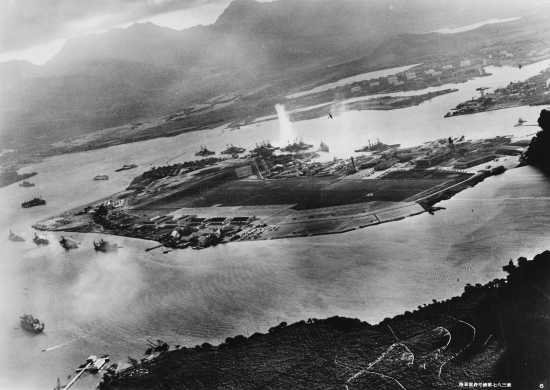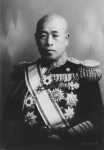Pearl Harbor, Dec. 7, 1941: The Day That Will Live in Infamy
Monday, December 5, 2016

Photograph taken from a Japanese plane during the torpedo attack on ships moored on both sides of Ford Island shortly after the beginning of the Pearl Harbor attack. View looks about east, with the supply depot, submarine base and fuel tank farm in the right center distance. A torpedo has just hit USS West Virginia on the far side of Ford Island (center). Other battleships moored nearby are (from left): Nevada, Arizona, Tennessee (inboard of West Virginia), Oklahoma (torpedoed and listing) alongside Maryland, and California. On the near side of Ford Island, to the left, are light cruisers Detroit and Raleigh, target and training ship Utah and seaplane tender Tangier. Raleigh and Utah have been torpedoed, and Utah is listing sharply to port. Japanese planes are visible in the right center (over Ford Island) and over the Navy Yard at right. U.S. Navy planes on the seaplane ramp are on fire. Japanese writing in the lower right states that the photograph was reproduced by authorization of the Navy Ministry. (Public domain)
Everyone has certain moments of days in their life that stand out. Beside those personal days, there are days that were important to the nation, even the world. Many people point out that for them it was the moment they heard that President Kennedy had been shot. For me, it was the afternoon of 12/7/41, 75 years -- three quarters of a century ago. Wow! Amazing!
In Plainview, Nebraska, it was unusually warm for a December day. I was 13 years old and in the eighth grade in school. A couple of buddies and I had been to a matinee at the Plains Theater -- "Navy Blues," a very funny, light-hearted show about the peace-time Navy, starring two of my favorites, Jack Oakie and Martha Raye. We were still laughing as we exited the theater, blinking in the bright sunlight. On the sidewalk that happy mood changed abruptly. We were met by another chum, Kenny Dickinson, who gave us the news that the Japanese had bombed our naval base at Pearl Harbor, and a lot of our sailors had been killed.
Kenny's news was necessarily sketchy, but it started a lively conversation -- just where was Pearl Harbor?" What would such an attack mean for the country?

Admiral Yamamoto
That evening we looked up Pearl Harbor and Oahu in the atlas and were glued to the radio late into the night. Next day, at school, Mrs. Chase, the Junior High principal herded us all over to the High School gym to hear President Roosevelt's "This Day Will Live in Infamy" speech to the nation, in which speech he declared war on both the Japanese and Nazi Germany.
That was the beginning of great changes in the United States -- changes we endured for the next three and a half years -- boys leaving for service, little blue star flags marking the home of a serviceman (to be replaced all too often with a little gold star flag, indicating a service man killed), shortages in almost everything. Soon we had rationing of sugar, lard, tires, and gas. New cars and trucks were simply not to be had -- all those things went to help our boys in service.
Those were difficult times for Americans. Yet, the war was responsible for another change for the American people. We were united, like never before -- or since. Everyone was in the same situation. The only thing that was really important was winning the war, and to do that we all had to work together -- and we did. We had one President, and we all supported him -- Republicans and Democrats alike. We expected him to save our country and it was our job to see that he was successful, everyone, men and women, and kids. We were all on the same page.
Over the next days and weeks following the Japanese sneak attack on Pearl Harbor we began to get details about the attack, its aftermath, and the days leading up to Dec. 7.
Apparently, both Japan and the United States had been suspicious of one another's actions in the Pacific since the 1920s. Those suspicions for the US were confirmed in the 1930s when Japan invaded Manchuria in 1931, leading to the Sino-Japanese War in 1937.
In 1940 Japan invaded French Indo-China and attempted to put unrealistic tariffs on Chinese imports from the US. When the US retaliated by restricting oil exports to oil-starved Japan, the Japanese formed a plan to control all of the Pacific through their 'Greater East Asia Co-Prosperity Sphere." However, standing in the way of this ever happening, was the long-time friend of the US, the Philippine Islands, which Japan knew the US would defend.
Instead of invading the Philippines and waiting for the inevitable American counter attack, Japanese military leaders, led by Admiral Yamamoto, planned the attack on Pearl Harbor, where the American fleet was based.
It took most of a year for Yamamoto to convince the Japanese Naval Authority, the other military leaders, and gain Emperor Hirohito's blessing -- a year spent training Japanese pilots (including Japanese suicide -- Kamakazi pilots) and readying the naval ships for such an attack. By early December 1941 the Japanese plan was in place.
Since the late '30s, the United States had begun tightening trade restrictions with Japan, in an effort to discourage Japanese aggression in China. Nothing seemed to work. In 1940 the alarm bells really increased in the US and Britain when Japan signed the Tripartite Pact with Nazi Germany and Fascist Italy, which officially formed the Axis Powers.
This was too much for Britain's Prime Minister Churchill, who pressured President Roosevelt to declare war on the Axis Powers. In America there was strong sentiment for keeping the US out of and war, and Japan continued to give diplomatic indications that the Japanese wanted peace with the United States, and their differences could be solved if both sides would compromise. The Japanese also planted the idea that it would be foolhardy for the United States to engage in a war in both the Pacific and in the Atlantic at the same time.
Japan felt that the war in Europe would distract the US enough that Japan would not be confronted over their aggressions in the Pacific. Roosevelt even bolstered that belief, when he implied that even an invasion of the Philippines could not provoke the US into war.
In '41 US Admirals cautioned the keeping of the entire fleet in Pearl Harbor. Roosevelt responded that a naval force at Pearl Harbor would act as a deterrent against further aggression.
On the morning of Dec. 7, 1941, Japanese diplomats in Washington prepared for yet another diplomatic session that would ease tensions in the Pacific.
The Japanese saw the American Pacific fleet as a formidable challenge to their Pacific aspirations. If the fleet could be destroyed, or neutralized the Americans could not offer aid and assistance to American, British, or Dutch colonies in the Pacific. The entire fleet, assembled at Pearl Harbor seemed to be an opportunity to rid that obstacle to their plans in one fell swoop.
The Japanese fleet that approached Hawaii on Dec. 7 was unprecedented in Naval warfare. It consisted of six aircraft carriers, carrying 135 Zero fighters, 97 torpedo bombers, and 108 dive bombers -- the greatest naval air force in history at the time. In addition there were two fast battleships, two heavy cruisers, one light cruiser, nine destroyers, 20 fleet subs, and five two man midget subs, and eight oilers for underway refueling.
American preparations for an attack on Pearl Harbor were woefully lacking. Intelligence was good, but the belief was that if war came it would start much further east, in the Philippines.
The attack on Pearl Harbor began early on Sunday, Dec. 7 -- at 7:42 am Hawaii time. The people on Oahu Island, both military and civilian were just beginning to stir. It would have to be considered a total success, from a Japanese point of view. The attack came in two waves. In all, eight American battleships were damaged -- four sunk. All except the USS Arizona were raised and six of the eight saw combat against the Japanese later in the war Also sunk or badly damaged were three cruisers, three destroyers, one anti-aircraft ship, one mine layer, 188 US aircraft. 2,403 Americans were killed and another 1,178 were wounded!
In contrast, the losses on the Japanese side, for a battle of this magnitude, were minimal -- 29 aircraft lost, five midget subs, and 64 Japanese service men killed, one sailor captured.
It took a bit for Americans to get over the complete and profound shock of the attack, but then we rolled up our sleeves and prepared to do what was needed to win the war. "Remember Pearl Harbor" became a rallying cry for the nation. The song, "Remember Pearl Harbor" told the story. "...We will always remember how they died for liberty, so Let's remember Pearl Harbor and go on to victory!"
Because there was no declaration of war and no warning, the attack was judged by the later Tokyo War Crimes Trials to have been a war crime.
Seven high ranking Japanese military men were hung. Admiral Yamamoto had been killed by American forces at Bouganville.

